“To vibrate with the rhythm of the Cosmos means to realize all the majesty of the Infinite.”
RHYTHM and PERIODICITY
Rhythm and period are two great and important concepts which have a common origin, which is evident in sound as number.
A sound, that is an entity that can be experienced, can exist only by means of a rhythmic periodicity of an oscillating instrument (string, air, etc.),
The unilateral rule according to which rhythm is a property of the organic, the living, and cadence is a property of that which is without life, the inorganic, cannot be accepted. The very cadence of inorganic periods (such as the orbits of the stars or the times employed to traverse them) involves a certain tolerance, never completely respected, while the broad liberty of organic rhythms always has an ideal cadence as a rhythmic basis, as otherwise they would not be recognizable.
It is true that, in current use, the term “rhythm” is reserved especially for what is spiritual and artistic, the term “period” for what is natural, and the term “cadence” for what is technical, but it would be unjust to be rigid about these distinctions. A man, for example, can be rhythmic as regards movements, while he has an organism which is periodic in its various functions and, moreover, technically he can respect the most exact cadences.
* * *
“Only the heart that embraces the whole world pulsates with the same rhythm as the Cosmos.”
RHYTHM
In the figurative arts, in poetry and in music, the inner rhythm is the basis of any composition.
Ancient architecture, according to what distant sources (Vitruvius and others) report, was based on harmonic measures, and it was fundamental to proportion space according to a chord of three sounds. Poetry is ruled by the metre. In painting and sculpture, a certain rhythmic order of colours, design and form is indispensable. All this demonstrates that in art the “thing” is secondary with respect to the “how”; and the latter is nothing besides the inner rhythm of the figurative medium (colours, lines, spatial forms).
In music, rhythm has a twofold aspect: it is in a symmetry and correspondence between the elements of the musical form and also in a metrical measurement, the musical beat. It is curious that for musical rhythms the numbers 2 and 3 are sufficient; as we can perceive only times subdivided into 2 or 3 parts. Five is already heard as the sum of 2 + 3, or of 3 + 2. We shall see, later on, that with these two numbers alone one can build a complete musical scale.
For the interpretation of rhythmicity in general, the first numbers are sufficient, as far as one can see. In this field also the senarius, that is, the numbers from 1 to 6, is sufficient.
***
“When man’s actions affirm the attraction of the spheres, it will be possible to establish a state of harmony based on the cosmic Magnet.”
PERIOD
To understand this concept, it is a good idea to seek it in the three kingdoms of nature and also in the field where human will is expressed, that is, history.
The idea of cosmic periods has been well known since very ancient times. In harmonics, for example, the third law of Kepler is important, which he discovered as a result of harmonic research, and establishes a harmonic relationship between periods of space and time. Let us recall what is called the platonic year, which is a cycle of 25,920 years; the period of sunspots, of the elements, the periods of geological ice ages, etc.
Living organisms also, still very little studied, reveal periods in their development.
Harmonic research perhaps has as its most important task precisely a survey of temporal forms, especially of periods. To carry it out, it will be necessary to create, analogously to Geometry, also a harmonic Chronometry or, if you wish, a mathematics of temporal figure. In other words, the forms of time must find their discipline, analogous to that of the forms of space.
The introduction of psychic values into the numbers of forms of time not only allows one to understand them in a more penetrating way but uses a faculty of knowing which has the closest relationship with time: the temporal perception of sounds.
The study of historical periods also, just started, has already given the wonderful result of a kind of morphology of history (Spengler).
***
“Rhythm is seen in the Cosmos as a rational renewal … Accept with joy this eternal movement.”
CADENCE
As already stated, the habit has become established of associating this concept with what is dead, sterile, mechanistic, opposed to rhythm.
Machines certainly show cadence in an extreme way. But it is not cadence which is responsible for their fury, but human devilishness, certainly not for the good, but for the evil of civilization. After all, the fundamental and persistent “inconclusiveness” of any cadence even in the sphere of a forced technique indicates a field which is precisely the opposite: that of an ideal sphere of laws and duties. The most precise machine is never precise enough; and this “imprecision” is inherent in the very idea of machine.
***
“Polarity is that property which determines harmony.”
MODERATION
Rhythm is in the whole and in every thing – this can be said without exaggeration. But it is well to remember that other great, primordial principles also have equal weight, such as: polarity, proportions, quanta, trinity, unity, etc.
***
“Those spirits which go forward linking with each other are so well attuned that their analogy composes excellent and very pure harmonies.”
TRANSFORMATION OF RHYTHM INTO SOUND. THE SIREN
A very interesting experiment has been carried out and proposed by W. Opelt, with the aim of passing from rhythms to sounds, intervals and so to chords.
Firstly, he develops the system of the principal musical rhythms (composed with the 2, 3 and 5). A similar thing had already been done by Helmholtz, in his theory of waves and also by Eulero.
On a segment established as equal to 1 are traced, as points, the rhythmical relationships of the simple numbers. The first eight lines of the figure represent the unit and the rhythmic subdivisions of 1/4, 1/5, 1/6, 1/8, 1/10, 1/12, 1/16. Other lines follow, grouped three by three, each of which represents a combined rhythm, which is marked at the side in the last five lines also with the corresponding sound or interval (be careful, it is still a question only of rhythms, not of sounds!) The figure which follows shows the foregoing.[1]
With his drawing, Opelt makes it possible to bring back even the most complex rhythms to a common denominator, that is to understand their logic.
How can we transform these rhythms into sounds? It is easy, we say today. It is sufficient to transform the rhythmical numbers into frequencies, to hear the corresponding sounds. But this modern method accentuates so greatly the abstract relationship of frequencies, that too often one finishes by neglecting their rhythmical origin or one does not think of it all.
It is therefore appropriate to learn a system of conversion, which transforms rhythms into sounds in a way which is both visible and exact. The simplest instrument to this end is the siren.
Opelt used a disc of cardboard about 30 cm in diameter and marked on it concentric circles which he subdivided with holes corresponding to the primary rhythms. The following figure represents this experiment:
Placing the disc in rotation, one blows with a pipe on the circles thus perforated. It is evident that higher or lower sounds are obtained with greater or lesser speed of rotation; however the tonal relationships between the various circles remain unchanged. Today, it is easy to have at one’s disposal motors which guarantee a constant speed of rotation. If then one supposes that the disc turns at a constant speed, the circles, for example, which are subdivided by the holes into 4, 8 and 16 parts sound the three octaves of Do, which in fact occurs. The second circle (starting from the inside) then sounds the fifth of Do, that is So, as it is divided into 6 parts (2 x 3) and in a similar way the other intervals are obtained.
So by means of the siren the monotonous rhythms are transformed into the corresponding sounds, that is, one passes (and it is really marvellous) from a series of equidistant holes on a circumference to a determined sound. The holes set at these intervals are seen and the sounds are heard! When, by the rotation of the disc, the rhythm disappears, that is when the single beats are no longer heard as detached, sound is born – as was to be demonstrated.
The research, with the same system, into combined rhythms is perhaps still more interesting. Opelt subdivided the external part of the disc into twelve sections, and the circles in a similar way to what was done with the linear segments of Figure 13.
In this way the intervals are heard, for example those of 5/4 or 4/3 or 7/4, which are real chords, that is sounds composed of two sounds.[2]
EMERGING CONSIDERATIONS
In this chapter, Hans Kaiser defines and illustrates three different qualities of the temporal concept of the cycle: rhythm, period and cadence. He then expounds a system for passing from rhythms to sounds, which is so simple and easy that it recalls the monochord.
Each one of these subjects is so inclusive that one certainly cannot think of giving them enough space in written pages. But in our opinion the Author did not enter with sufficient vigour into these essential values of creative life. After these pages, in all his monumental work, the idea of the rhythmic cycle reappears only rarely and hazily. There is no balance between the study dedicated to the properties of the forms and that reserved for the movement and the fundamental cycle of energy. He seems to think that, as rhythm can be transformed into sound, it is enough to consider the latter.
We do not intend to make criticisms of a work which is so precious and so beloved. This is only the finding of a door which remained half closed, through which the Author did not pass. Yet only through it one enters into the kingdom of Fire which burns eternally in Space. In the whole Treatise, not a phrase is reserved for dance, which is the poetry of movement. Likewise the creative values of the gesture and the magic potency of rites are ignored. The figures, the diagrams and even the tonal coordinates of space are not thought to be animated by a rhythmic motion, according to the great cycles of energy, which yet produce the qualities of all forms. The failure to see this door cost the Author a superior level of spiritual comprehension.
The energies of Space reach us on the waves of cosmic rhythms. The sensitive perception, study and observation of these pulsations and lastly concordant (harmonic) action with them, that is the precise correspondence introduced into life between the cycles of man and of the universe, destroy the forces which prevent free communion with Space and Fire. All this, in a few words, means living and lived astrology. This science is really inevitable on man’s way!
If it is true, as it is true, that in a musical form what counts most is not the melody, nor the tonality, nor the instrumentation, but the rhythm, to which the work owes its creative effectiveness and which, so to speak, supports it on sure and invisible wings and predetermines all its future “dates”, what must be the value and importance of a cosmic, or solar, rhythm! If the perception of sound brings one back to the psyche, rhythm brings one back to the spirit. It is a more subtle being than sound: it is its very soul; and nothing higher can be found which can still be expressed in thoughts and words.
We do not see that it is necessary, nor that these are times, to reduce the drive to study rhythm, despite today’s evident distortions and the dangers they involve. If the cycle of this manifestation is now, as is believed, in the phase which corresponds to its winter solstice, that is in its most dark and dense section, this is really the most propitious hour for investigating and supporting the signs of the great return of the light, and for starting great beginnings with small actions.
***
It is the sacred epoch of the heart and of Space.
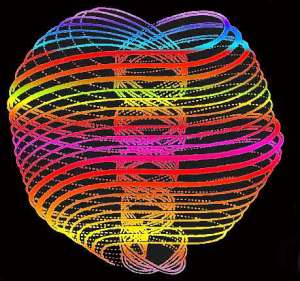
For the doctor of today, the human heart is only a pump. But who can say that its pulsation is an inconclusive mechanical cadence? On the contrary, it is a very variable rhythm, which reflects exactly and faithfully the changing relationships between man and the cosmos. Many people know and experience the fact that the movements of the heart vary mysteriously and continuously. The consideration of this evidence is sufficient to “dismantle” that pump for ever. In its place we see a psycho-physical organ, rhythmical and of a kind that adjusts other organs to the variable conditions of environmental energy and at the same time reveals these conditions so that they can be interpreted and suitable “measures” can be taken, if necessary.
Besides, if rhythm is of such sublime value in the Cosmos, the most suitable organ for studying it can only be the most rhythmical and sensitive human organ. For this investigation the brain is not adequate. The continual vigilance and interpretation of the very changeable cardiac rhythms, with the subtle sensations which accompany them, must in some way favour the understanding of the relationships which link us to infinite Space. The very form of the heart, which encloses a changing space traversed by continual currents, varying from moment to moment, must be fundamental in the Cosmos.
Modern western man has discovered many physical energies and how to transform one to another with the most diverse means. But he has not yet recovered the idea, majestic and simple, that all the energies, physical and non-physical, are forms or aspects assumed by a single Energy, to which the name of Fire is well suited. The ancients knew it, who also knew its fundamental cycle.
Here is a famous symbol which represents it:
After a brief, elementary study of the horizon, it is concluded that man lives closed in this cycle which conditions him in all his acts and qualities.
* * * * * *






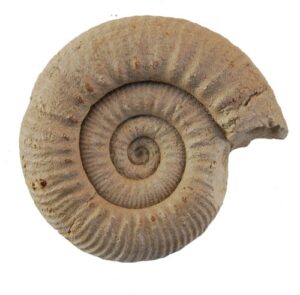
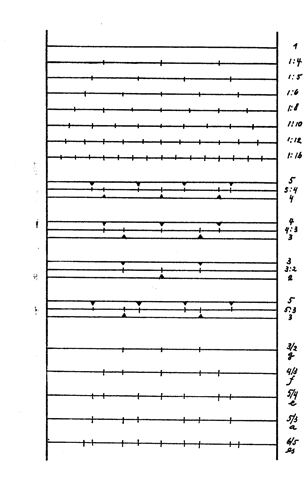
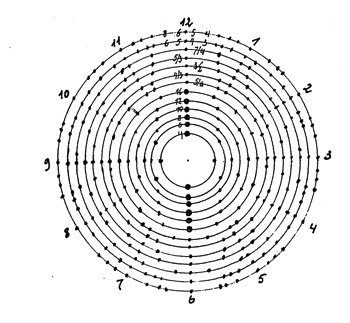
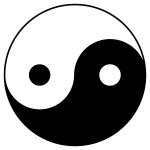

Pingback: Music and Color in Nature – TPS Blog – English Area